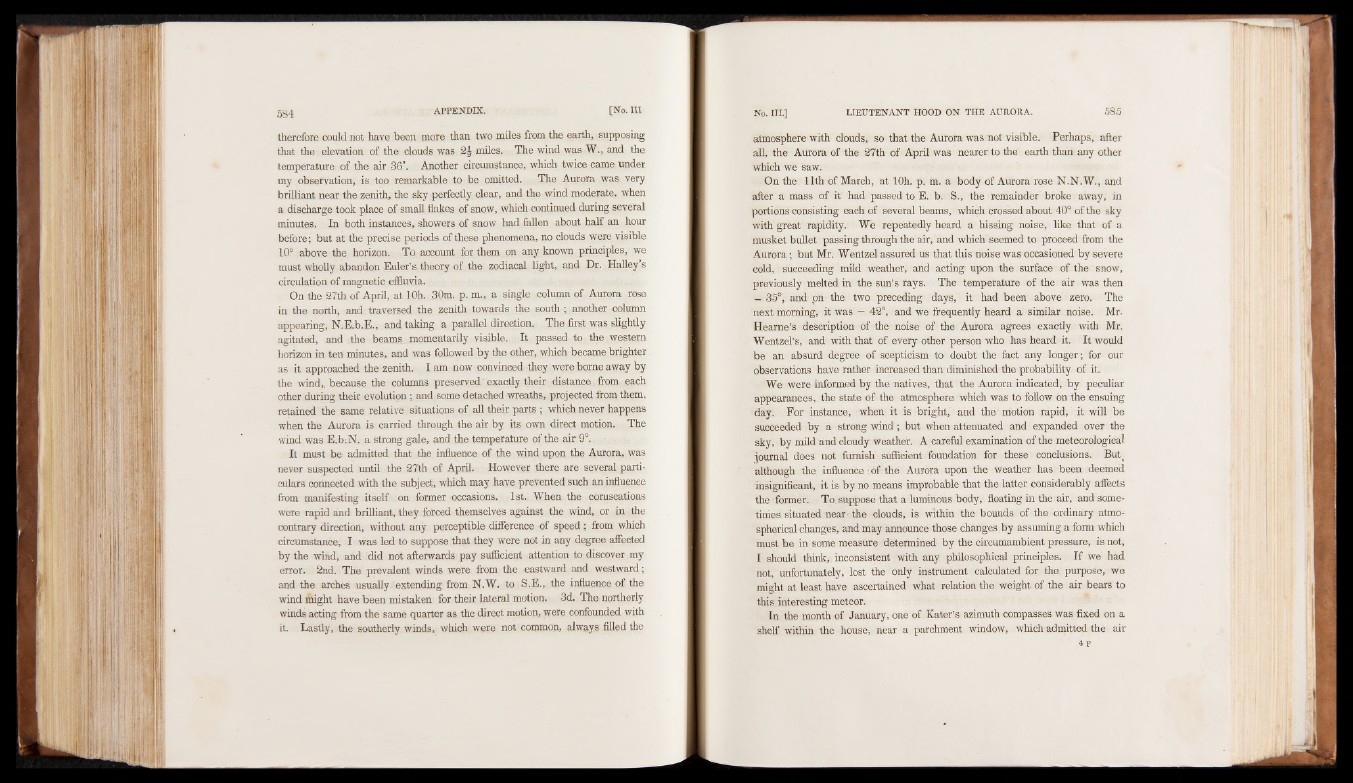
therefore could riot have been more than two miles from the earth, supposing
that the elevation of the clouds was 2J miles. The wind was W., and the
temperature of the air 36°. Another circumstance, which twice came under
my observation, is too remarkable to be omitted. The Aurora was very
brilliant near the zenith, the sky perfectly clear, and the wind moderate, when
a discharge took place of small flakes of snow, which continued during several
minutes. In both instances, showers of snow had fallen about half an hour
before; but at the precise periods of these phenomena, no clouds were visible
10° above the horizon. To account for them on any known principles, we
must wholly abandon Euler’s theory of the zodiacal light, and Dr. Halleys
circulation of magnetic effluvia.
On the 27th of April, at lOh. 30m. p. m„ a single column of Aurora rose
in the north, and traversed the zenith towards the south ; another column
appearing, N.E.b.E., and taking a parallel direction. The first was slightly
agitated, and the beams _ momentarily visible. It passed to tfie western
horizon in ten minutes, and was followed by the other, which became brighter
as it approached the zenith. I am now convinced they were borne away by
the wind,, because the columns preserved 'exactly their distance from each
other during their evolution; and some detached wreaths, projected from them,
retained the same relative situations of all their parts ; which never happens
when the Aurora is carried through the air by its own direct motion. The
wind was E.b;N. a strong gale, and the temperature of the air 9°.
It must be admitted that the influence of the wind upon the Aurora, was
never suspected until the 27th of April. However there are several particulars
connected with the subject, which may have prevented such an influence
from manifesting itself on former occasions. 1st. When the coruscations
were rapid and brilliant, they forced themselves against the wind, or in the
contrary direction, without any perceptible difference of speed; from which
circumstance, I was led to suppose that they were not in any degree affected
by the wind, and did not afterwards pay sufficient attention to discover my
error. 2nd. The prevalent winds were from the eastward and westward;
and the arches usually extending from N.W. to S.E., the influence of the
wind might have been mistaken for their lateral motion. 3d. The northerly
winds acting from the same quarter as the direct motion, were confounded with
it. Lastly, the southerly winds, which were not common, always filled the
atmosphere with clouds, so that the Aurora was not visible. Perhaps, after
all, the Aurora of the 27th of April was nearer to the earth than any other
which we saw.
On the 11th of March, at lOh. p. m. a body of Aurora rose N.N.W., and
after a mass of it had passed to E. b. S., the remainder broke away, in
portions consisting each of several beams, which crossed about 40° of the sky
with great rapidity. We repeatedly heard a hissing noise, like that of a
musket bullet passing through the air, and which seemed to proceed from the
Aurora; but Mr. Wentzel assured us that this noise was occasioned by severe
cold, succeeding mild weather, and acting upon the surface of the snow,
previously melted in the sun’s rays. The temperature of the air was then
— 35°, and on the two preceding days, it had been above zero. The
next morning, it was — 42“, and we frequently heard a similar noise. Mr.
Hearne’s description of the noise of the Aurora agrees exactly with Mr.
Wentzel’s, and with that of every other person who has heard it. It would
be an absurd degree of scepticism to doubt the fact any longer; for our
observations have rather increased than diminished the probability of it.
We were informed by the natives, that the Aurora indicated, by peculiar
appearances, the state of the atmosphere which was to follow on the ensuing
day. For instance, when it is bright, and the motion rapid, it will be
succeeded by a strong wind; but when attenuated and expanded over the
sky, by mild and cloudy weather. A careful examination of the meteorological
journal does not furnish sufficient foundation for these conclusions. But;
although the influence of: the Aurora upon the weather has been deemed
insignificant, it is by no means improbable that the latter considerably affects
the former. To suppose that a luminous body, floating in the air, and sometimes
situated near-the clouds, is within the bounds of the ordinary atmospherical
changes, and may announce those changes by assuming a form which
must be in some measure determined by the circumambient pressure, is not,
I should think,, inconsistent with any philosophical principles. If we had
not, unfortunately, lost the only instrument calculated for the purpose, we
might at least have ascertained what relation the weight of the air bears to
this interesting meteor.
In the month of January, one of Eater’s azimuth compasses was fixed on a
shelf within the house, near a parchment window, which admitted the air